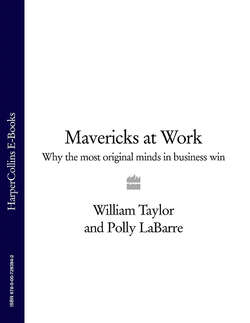Читать книгу Mavericks at Work: Why the most original minds in business win - William Taylor - Страница 24
ОглавлениеChapter Four
Ideas Unlimited: Why Nobody Is as Smart as Everybody
Gold mining is an old industry, a tired industry. The pace of change is glacial. Traditionally, mining companies have worried about how strong your back is, not how big your brain is. We wanted to do something that no one in the industry had done, to tap into the intellectual capital of the whole world.
—ROB MCEWEN, FORMER CHAIRMAN AND CEO, GOLDCORP, INC.
Rob McEwen was running out of ideas—and out of patience. It had been more than five years since he’d made a gamble that most executives in his business thought was fool’s gold, acquiring a mine with a history of low productivity, bare-bones investment, and bitter labor relations. But McEwen’s mine was in the Red Lake district of northwest Ontario, which, since the discovery of gold there in the 1920s, has produced more than 24 million ounces, nearly 10 percent of gold-rich Canada’s total output. And this out-of-favor property bumped up against the reliably productive Campbell Lake mine, which had churned out 9 million ounces over the years.
There had to be rich deposits of ore somewhere below his 55,000-acre site, McEwen reasoned. But where? So he raised the stakes and provided his geologists at Goldcorp, Inc., with a fresh $10 million to spend on exploration at the capital-starved Red Lake mine, situated more than 1,300 miles from company headquarters in downtown Toronto. Soon, the geologists reported some tantalizing news: in nine of the exploratory holes they had drilled, the average concentration of ore was 30 times richer than what Red Lake was currently producing. Eureka! Goldcorp had discovered gold. But the discovery raised as many questions as answers. How big was the deposit? McEwen and his geologists didn’t know. Where were the best spots to transition from exploration to deep drilling? The team couldn’t say. How much time and money would it take to figure it out? No one was prepared to offer a firm estimate.
Another year went by as Goldcorp struggled to make sense of its promising find and to understand just what it was sitting on. Tired, frustrated, and eager for a break from the grind, McEwen, an unabashed science and technology enthusiast, decided to spend a week at MIT with a delegation of presidents and CEOs from other companies, learning about trends in information technology. Part of the weeklong program focused on Linux and open-source software—computer code written by programmers scattered all over the world, people who are passionate enough about their craft, or who have a strong enough stake in the success of the project on which they work, to volunteer their time and expertise to write software that no company owns but millions of people can’t live (or at least work) without. For years open-source programs such as Apache, Perl, and Sendmail have been the unseen, mission-critical backbone of the Internet. It’s a taken-for-granted part of life among the Internet cognoscenti, but something of a mind-bender for us civilians: the world’s most important technology platform relies on ideas and computer code generated largely by a decentralized corps of volunteer programmers, most of whom have never met one another and few of whom work together in any formal setting.*
In the case of Linux, a worldwide collection of grassroots, self-directed teams have built an operating system that powers a fast-growing share of the world’s computer servers—and has become a power player in the software industry. Some of the biggest technology companies in the world, including IBM, Hewlett-Packard, and Intel, devote hundreds of programmers and major financial resources to the Linux cause. But the real action is with the grassroots volunteers who cook up features, write code, fix bugs—and share their ideas with everyone else on the project.
The more McEwen learned about the open-source phenomenon, the more intrigued be became. People didn’t have to work for his company, he realized, in order to work with his company. He could prospect for drilling strategies from the farthest reaches of the world. “All of a sudden a light went on,” he recalls. “It was like a flash: this is the template I’ve been searching for! I went running back to Toronto convinced that we had to change how Goldcorp thought about mining. I wanted us to create a new approach to exploration at Red Lake.”
McEwen sketched the outlines of his idea to Goldcorp’s geologists and executives. The company would use the Internet to post all of its data on the mine—50 years worth of maps, reports, and raw geological information—along with software that displayed the data both in two dimensions and three dimensions. It would then invite scientists and engineers from anywhere in the world to download the data, analyze it as they saw fit, and submit drilling plans to Goldcorp, which would convene a blue-ribbon panel of judges to evaluate the submissions. The goal would be to help the company find its next 6 million ounces of gold.*
